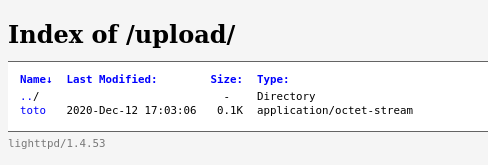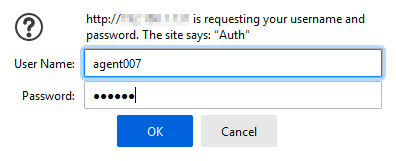Set Up HTTP File Sharing on Debian with Lighttpd
- Last updated: Jul 5, 2025
If you have a good Internet connection, you might find it useful to share files with friends using a simple home-made solution.
In this guide, we’ll show how to set up a web server for easy file sharing over the HTTP protocol on GNU/Linux.
The goal is to keep things quick and minimal in terms of configuration.
We’ll be using Lighttpd, an open-source web server optimized for speed-critical environments, while remaining standards-compliant, secure, and flexible. For more information, see the Wikipedia page: https://en.wikipedia.org/wiki/Lighttpd.
In short: low CPU usage and a small memory footprint — exactly what we're looking for.
- Configuration:
- OS: Debian 12
- Web Server: Lighttpd
Installing Lighttpd
- Install the lighttpd package:
root@host:~# apt update && apt install lighttpdEdit Configuration File
- Now edit the main configuration file at
/etc/lighttpd/lighttpd.conf, and add these two lines:
server.modules = (
"mod_indexfile",
"mod_access",
"mod_alias",
"mod_redirect",
)
server.dir-listing = "enable"
dir-listing.encoding = "utf-8"
server.document-root = "/var/www/html"
server.upload-dirs = ( "/var/cache/lighttpd/uploads" )
server.errorlog = "/var/log/lighttpd/error.log"
server.pid-file = "/var/run/lighttpd.pid"
server.username = "www-data"
server.groupname = "www-data"
server.port = 80
# strict parsing and normalization of URL for consistency and security
# https://redmine.lighttpd.net/projects/lighttpd/wiki/Server_http-parseoptsDetails
# (might need to explicitly set "url-path-2f-decode" = "disable"
# if a specific application is encoding URLs inside url-path)
server.http-parseopts = (
"header-strict" => "enable",# default
"host-strict" => "enable",# default
"host-normalize" => "enable",# default
"url-normalize-unreserved"=> "enable",# recommended highly
"url-normalize-required" => "enable",# recommended
"url-ctrls-reject" => "enable",# recommended
"url-path-2f-decode" => "enable",# recommended highly (unless breaks app)
#"url-path-2f-reject" => "enable",
"url-path-dotseg-remove" => "enable",# recommended highly (unless breaks app)
#"url-path-dotseg-reject" => "enable",
#"url-query-20-plus" => "enable",# consistency in query string
)
index-file.names = ( "index.php", "index.html" )
url.access-deny = ( "~", ".inc" )
static-file.exclude-extensions = ( ".php", ".pl", ".fcgi" )
compress.cache-dir = "/var/cache/lighttpd/compress/"
compress.filetype = ( "application/javascript", "text/css", "text/html", "text/plain" )
# default listening port for IPv6 falls back to the IPv4 port
include_shell "/usr/share/lighttpd/use-ipv6.pl " + server.port
include_shell "/usr/share/lighttpd/create-mime.conf.pl"
include "/etc/lighttpd/conf-enabled/*.conf"
#server.compat-module-load = "disable"
server.modules += (
"mod_compress",
"mod_dirlisting",
"mod_staticfile",
)- Create an upload directory:
root@host:~# mkdir /var/www/html/upload- Create a test file:
root@host:~# echo "titi" > /var/www/html/upload/toto- Restart the lighttpd service:
root@host:~# systemctl restart lighttpd.serviceConnect to the Web Server
Open your web browser and go to the following URL, replacing IP_ADDRESS with your server’s actual IP: http://IP_ADDRESS/upload. You should see a directory listing with your test file visible under the Index of /upload/ page:

Securing Your Web Server
Your HTTP server is now up and running. However, if it's accessible from the Internet (which is likely the goal), it means that anyone can potentially connect to it.
Let’s look at a few ways to improve its security.
Restrict Access with a Firewall
You can use iptables or nftables to limit access to specific IP addresses only.
Using iptables
root@host:~# iptables -A INPUT -p tcp --dport 80 -m state -s ALLOWED_IP --state NEW,ESTABLISHED,RELATED -j ACCEPTroot@host:~# iptables -A INPUT -p tcp --dport 80 -m state --state NEW,ESTABLISHED,RELATED -j DROPUsing nftables
root@host:~# nft add rule ip filter INPUT tcp dport 80 ip saddr ALLOWED_IP ct state new,established counter acceptroot@host:~# nft add rule ip filter INPUT tcp dport 80 ct state new,established counter dropAdd Basic Authentication
To prevent unwanted users from accessing your files, you can enable a username/password prompt.
- Edit the configuration file
/etc/lighttpd/lighttpd.confand add the following lines:
server.modules = (
"mod_indexfile",
"mod_access",
"mod_alias",
"mod_redirect",
"mod_auth",
"mod_authn_file"
)
auth.backend = "plain"
auth.backend.plain.userfile = "/etc/lighttpd/lighttpd-plain.user"
auth.require = ( "/" =>
(
"method" => "basic",
"realm" => "Auth",
"require" => "valid-user"
)
)- Create a new user by specifying a login:password pair in a plain text file:
root@host:~# echo "agent007:secret" > /etc/lighttpd/lighttpd-plain.user- Restart the Lighttpd service to apply the authentication settings:
root@host:~# systemctl restart lighttpd.service- Now, when someone accesses the server, a login prompt will appear requesting valid credentials:

Add HTTPS Support
To encrypt traffic between your server and clients, you can enable HTTPS by creating a self-signed certificate and configuring Lighttpd accordingly.
- Create a Self-Signed Certificate:
root@host:~# openssl req -x509 -nodes -days 3650 -newkey rsa:4096 -keyout /etc/ssl/private/lighttpd-selfsigned.key -out /etc/ssl/certs/lighttpd-selfsigned.crt- Then combine the key and certificate into a single file:
root@host:~# cat /etc/ssl/private/lighttpd-selfsigned.key /etc/ssl/certs/lighttpd-selfsigned.crt > /etc/lighttpd/cert.pem- Restrict access to the certificate file:
root@host:~# chmod 600 /etc/lighttpd/cert.pem- Edit
/etc/lighttpd/lighttpd.confand add the following to enable HTTPS:
server.modules = (
"mod_indexfile",
"mod_access",
"mod_alias",
"mod_redirect",
"mod_auth",
"mod_authn_file",
"mod_openssl"
)
$SERVER["socket"] == ":443" {
ssl.engine = "enable"
ssl.pemfile = "/etc/lighttpd/cert.pem"
}- Restart the lighttpd service:
root@host:~# systemctl restart lighttpd.service